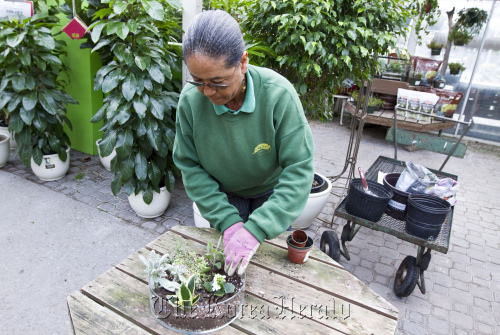Terrariums are totally trendy again.
So says Southern Living magazine in its November issue. So say garden centers, which are increasingly creating and showcasing them as miniature ways to garden on tabletops.
Terrariums take up little space, and require minimal care. In fact, they thrive on neglect. Just give them a little moisture every few weeks, and keep them away from direct sunlight.
These glorious glass gardens take just a few minutes to assemble. Even kids can help make them for teachers’ gifts, shut-in friends or family or as housewarming gifts for new neighbors. But, be sure to make one for yourself.
“Making a terrarium is not an exact science,” says Lucy Watkins, who creates dozens of terrariums for the greenhouse at McDonald Garden Center in Hampton, Virginia.
So says Southern Living magazine in its November issue. So say garden centers, which are increasingly creating and showcasing them as miniature ways to garden on tabletops.
Terrariums take up little space, and require minimal care. In fact, they thrive on neglect. Just give them a little moisture every few weeks, and keep them away from direct sunlight.
These glorious glass gardens take just a few minutes to assemble. Even kids can help make them for teachers’ gifts, shut-in friends or family or as housewarming gifts for new neighbors. But, be sure to make one for yourself.
“Making a terrarium is not an exact science,” says Lucy Watkins, who creates dozens of terrariums for the greenhouse at McDonald Garden Center in Hampton, Virginia.

“When you do a terrarium, you are using plants that are going to grow, so you have to leave room for them to grow. Avoid overcrowding your container and you will have fewer problems down the road.”
Glass containers are typically chosen for terrariums, but you can use anything around the house or anything you may find at a yard sale, flea market or antique sale. China tureens, antique bowls, old pottery or even unused wooden drawers can be used to hold the gravel, charcoal and potting soil needed to support the plants. Bell jars, glass cloches and even old pickle jars work. Terrariums need no drainage holes, so avoid the kind of pots used for container gardening outdoors or growing houseplants indoors.
Plants ideal for terrariums usually include 2- and 4-inch pots of baby plants like mosses, ferns, jade, kalanchoes, African violets, palms, snake plant and peperomias Miniature orchids add an elegant flare.
Here’s how to make a medium-size terrarium that can serve as a centerpiece for a dinner table or embellish a coffee table for a casual get-together. The principle is the same for any shape or size terrarium you would like to make. You can find the materials at garden centers, sometimes craft stores.
“Your imagination is your only limitation,” says Watkins.
Materials:
- 12-inch-wide, 6-inch-deep glass bowl
- Small bag of horticultural gravel
- Small bag of activated charcoal
- Small bag of potting mix
- Small bag of wood chips
- 5 plants: snake, jade and kalanchoe, each in 2-inch pots; succulent and moss, each in 4-inch pots.
Directions:
― Wash and dry container.
― Place a 1/2-inch layer of gravel for drainage on the bottom of the container.
― Sprinkle a few pieces of charcoal over the gravel (it keeps soil from smelling sour over time)
― Add a layer of potting soil, about 2-3 inches deep (leave soil at least 1 inch below rim of container); you can create a small slope of slightly deeper soil along one side of the container for a contoured look.
― Before placing each plant in the potting soil, gently soften and spread the root ball, just a little, so you open up it up in the middle for good root growth.
― Position the plants one by one in the potting mix.
― Sprinkle a few decorative wood chips in selected spots, but do not cover the soil entirely.
― Add decorative accents, if desired, like a miniature elf sitting under a small toadstool. Seashells, glass beads/marbles, tiny ceramic animals and even small pieces of driftwood also work. Water very lightly, preferably just a few drops around each root ball.
Terrarium tips
Avoid over watering; succulents need little water while mosses need more so water plants individually, as needed. A terrarium with a closed glass top only needs water when condensation ceases or plants wilt.
Place terrarium in diffused light, not direct sun light; plants in a terrarium grow nicely under fluorescent lights in offices and homes.
Rotate the terrarium slightly every few days, if placed near a window, for overall health.
When plants get to the size you want to maintain them, pinch off the tips, or new growth.
Fertilizer is not really needed because you want to keep the plants small.
By Kathy Van Mullekom
(Daily Press)
(Distributed by MCT Information Services)
-
Articles by Korea Herald











![[Today’s K-pop] BTS pop-up event to come to Seoul](http://res.heraldm.com/phpwas/restmb_idxmake.php?idx=644&simg=/content/image/2024/04/17/20240417050734_0.jpg&u=)





![[KH Explains] Hyundai's full hybrid edge to pay off amid slow transition to pure EVs](http://res.heraldm.com/phpwas/restmb_idxmake.php?idx=652&simg=/content/image/2024/04/18/20240418050645_0.jpg&u=20240419100350)

